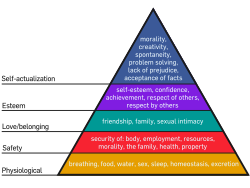User:Michaelchilliard/sandbox
The memory span procedure[edit]
In a typical test of memory span, a list of random numbers or letters is read out loud or presented on a computer screen at the rate of one per second. The test begins with two to three numbers, increasing until the person commits errors. Recognizable patterns (for example 2, 4, 6, 8) should be avoided. At the end of a sequence, the person being tested is asked to recall the items in order. The average digit span for normal adults without error is seven plus or minus two.[1] However, memory span can be expanded dramatically - in one case to 80 digits - by learning a sophisticated system of recoding rules by which substrings of 5 to 10 digits are translated into one new chunk.[2]
- ^ Miller, G. (1956). The Magical Number Seven, Plus or Minus Two: Some Limits on Our Capacity for Processing Information, Psychological Review, 63, 81–97.
- ^ Ericsson, K. A., Delaney, P. F., Weaver, G., & Mahadevan, R. (2004). Uncovering the structure of a memorist's superior "basic" memory capacity. Cognitive Psychology, 49, 191-237
Humanism[edit]

Humanistic psychology was developed in the 1950s in reaction to both behaviorism and psychoanalysis.[2] By using phenomenology, intersubjectivity and first-person categories, the humanistic approach sought to glimpse the whole person—not just the fragmented parts of the personality or cognitive functioning.[3] Humanism focused on fundamentally and uniquely human issues, such as individual free will, personal growth, self-actualization, self-identity, death, aloneness, freedom, and meaning. The humanistic approach was distinguished by its emphasis on subjective meaning, rejection of determinism, and concern for positive growth rather than pathology.[citation needed] Some of the founders of the humanistic school of thought were American psychologists Abraham Maslow, who formulated a hierarchy of human needs, and Carl Rogers, who created and developed client-centered therapy. Later, positive psychology opened up humanistic themes to scientific modes of exploration.
- ^ "Maslow's Hierarchy of Needs". Honolulu.hawaii.edu. Retrieved 2011-12-10.
- ^ Gazzaniga, Michael (2010). Psychological Science. New York: W.W. Norton & Company. p. 23. ISBN 9780393934212.
- ^ Rowan, John. (2001). Ordinary Ecstasy: The Dialectics of Humanistic Psychology. London, UK: Brunner-Routledge. ISBN 0-415-23633-9

